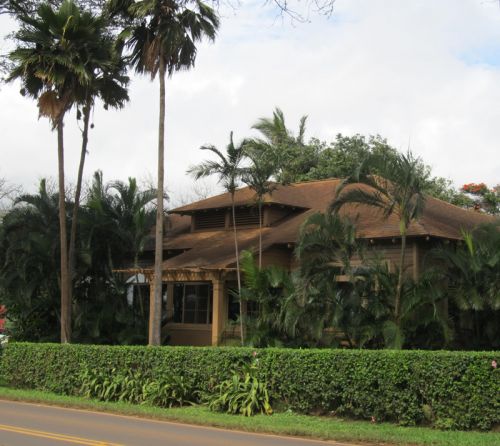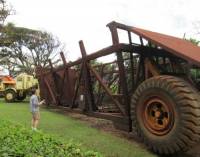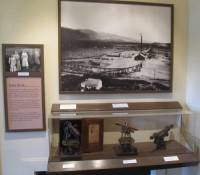
Although a trip to the island of Maui is treat enough, if you want to make your visit even sweeter, stop at the Alexander & Baldwin Sugar Museum in the town of Pu’unene. There are just six rooms in this 1902 former sugar plantation superintendent’s residence turned museum, plus a gift shop, but the 1,800 square feet of exhibits covers everything you want to know about the interesting history and heritage of Maui’s sugar industry. Across the road from the museum you’ll find Hawaii’s largest working sugar factory (no public tours), operated by the Hawaiian Commercial & Sugar Company. Before or after your self-guided museum tour, spend a little time wandering the grounds. Not only will you find dozens of native plants and palm trees, but also a Portuguese oven built in the 1920s, and some huge pieces of original cane harvesting equipment.
 The corporation known today as Alexander & Baldwin, Inc. with $2.3 billion in assets (from real estate development, commercial real estate, agriculture, infrastructure construction and more), humbly began in 1869. Boyhood friends Samuel Alexander and Henry Baldwin bought their first 12-acre parcel for $110 and planted sugar cane. Over the years, the partners built irrigation ditches, added more land, bought out other sugar plantations, and their business grew. Alexander moved to California in the early 1880s, but Baldwin remained on Maui and ran a profitable company. Today, some 36,000 acres of cane (looks like giant grass) create broad swatches of green across Maui’s lower volcanic slopes and sunny central isthmus, giving the island its lush, verdant look.
The corporation known today as Alexander & Baldwin, Inc. with $2.3 billion in assets (from real estate development, commercial real estate, agriculture, infrastructure construction and more), humbly began in 1869. Boyhood friends Samuel Alexander and Henry Baldwin bought their first 12-acre parcel for $110 and planted sugar cane. Over the years, the partners built irrigation ditches, added more land, bought out other sugar plantations, and their business grew. Alexander moved to California in the early 1880s, but Baldwin remained on Maui and ran a profitable company. Today, some 36,000 acres of cane (looks like giant grass) create broad swatches of green across Maui’s lower volcanic slopes and sunny central isthmus, giving the island its lush, verdant look.
 In the early days, immigrants from China, Japan, Puerto Rico, Korea, the Philippines, Portugal, Russia, Germany and Scandinavia provided much of the sugar cane industry’s hard labor. Families lived on sugar plantation camps and brought their customs and heritage with them. The museum’s “Plantation Room” contains religious items such as a Buddhist alter and various household artifacts brought to Maui by the immigrants. The “Field Room” includes displays of cane knives, surveying equipment, and everyday items such as lunch pails. A mannequin shows a Japanese woman’s complete fieldwork outfit— it covers nearly every inch of skin. To learn how cane is processed into sugar in modern-day Hawaii, be sure to watch the museum’s10-minute “From Cane to Sugar” video. Following your tour, satisfy your sweet tooth with a free sample of Maui Golden Natural Turbinado Cane Sugar. If you like it, there’s more for sale in the gift shop.
In the early days, immigrants from China, Japan, Puerto Rico, Korea, the Philippines, Portugal, Russia, Germany and Scandinavia provided much of the sugar cane industry’s hard labor. Families lived on sugar plantation camps and brought their customs and heritage with them. The museum’s “Plantation Room” contains religious items such as a Buddhist alter and various household artifacts brought to Maui by the immigrants. The “Field Room” includes displays of cane knives, surveying equipment, and everyday items such as lunch pails. A mannequin shows a Japanese woman’s complete fieldwork outfit— it covers nearly every inch of skin. To learn how cane is processed into sugar in modern-day Hawaii, be sure to watch the museum’s10-minute “From Cane to Sugar” video. Following your tour, satisfy your sweet tooth with a free sample of Maui Golden Natural Turbinado Cane Sugar. If you like it, there’s more for sale in the gift shop.
IF YOU GO:
Alexander & Baldwin Sugar Museum
3957 Hansen Rd,
Pu’unene, Maui, Hawaii 96732
Phone:(808) 871-8058
Located at the intersection of Mokulele Highway (route 311/350) and Hansen Road, approximately 10 minutes from Kahului Airport.
Open every day 9:30 a.m. to 4:00 p.m. Admission is $7 Adults, $5 Seniors 60 or better, $2 children ages 6 through 12 years; children ages 5 and under are admitted free.

Leave a Reply